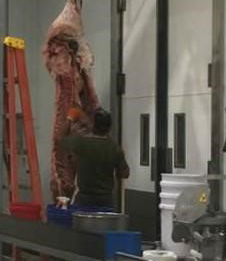
These signs became familiar sights for many of us in the Midwest after historic floods began in March 2019. They meant our drive would be different, longer or not possible at all. Bridges out and roads closed created challenges similar to those we have recently seen in the meat supply chain.
The meat supply chain has also been forced to be different, taken longer or not be possible at all due to the global pandemic. Let’s take a closer look at the similarities between the meat supply chain issues and bridge and road closures by comparing your car to a meat animal destined for your plate.
Imagine your car is a meat animal ready to be harvested. You drive down a familiar highway and see a road closed or bridge out sign. You have some options at this point:
- Take the detour that is miles longer
- Return home and park your car in the garage
- Teleport and magically get your car to its destination
- Take a small local two-lane road that is the shortest distance but has heavy traffic
Option 1– This compares to meat processing plants having to slow down production or close for a short time, due to limited employees The result is the meat on your plate is not as efficiently produced. At times it can seem like your car (the meat animal) will never make it to its destination (your plate). There may be fewer choices available and may be more expensive, but over time this will correct itself and supply will again meet demand. Panic buying or hoarding only make the detour longer.
Option 2– Return home and park your car in the garage. Except there is no room in the garage because another car is already parked there. Not only that, but you can’t turn off your car’s engine so it keeps burning fuel. Meat animals that cannot be processed in a timely manner keep burning fuel (feed), too. Unlike a car, the meat animals keep growing and soon their health and well-being are in danger. If the meat animals get too large, processors are not able or willing to adapt to this increase.

Option 3–No, this can’t really happen, but we can dream, can’t we? In a way, this is much like saying that meat animals should be taken to food banks or be provided to those who are food insecure. This is a great idea in principle but isn’t generally practical because turning a meat animal into food isn’t magic. Equipment, skill, time and food safety criteria are all involved. This photo shows the size of half a beef carcass. That half can weigh between 400 and 500 pounds. Most of us don’t have what it takes to make this into meat.
Half a beef carcass being processed at ASC Lockers, West Point, Neb.
Option 4–The small local road where traffic is backed up compares to taking meat animals to smaller regional or local processors and selling directly to those that will eat the meat. This works well, and my husband and I sell most of our beef this way. As you can see from this chart, however, the number of meat animals harvested each month in the U.S. far surpasses the capacity available even if you were to add all the small processors across the U.S together.
Meat Supplies
The average number of animals harvested per month.
Pigs………………………………10 million
Cattle……………………………2.7 million
Sheep…………………………..183 thousand
Turkeys………………………20.1 million
Chickens…………………….750 million
(source: https://www.meatinstitute.org/index.php?ht=d/sp/i/47465/pid/47465 )
As I visited with our local meat processor, Aaron Koch of ASC Locker in West Point, Nebraska, he shared with me that his capacity is about 100 to 110 head of beef and 50 to 60 head of pigs per month.
These options are unfamiliar to most. Just as we learned to be patient while traveling last year, we need to be patient with the meat supply chain this year. The absence of bridges was a reminder of how much we take them for granted. How often have you driven across a bridge and not even noticed? The safe, abundant, affordable meat supply we have enjoyed wasn’t noticed until it changed. No part of the meat supply chain should be taken for granted. Farmers like my husband and I, as the first link in that chain, are working hard to keep your food secure, safe, abundant and affordable.
Whenever you have questions about how your food is grown or what path it takes to your plate, be sure to look for credible, fact-based sources. Understand who is behind what you are hearing or reading and base your decisions on facts, not fear.
